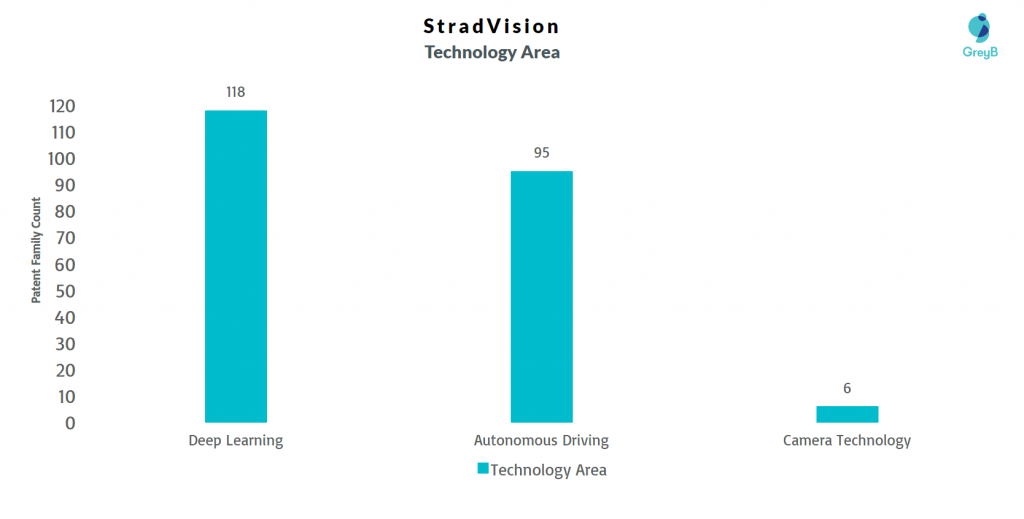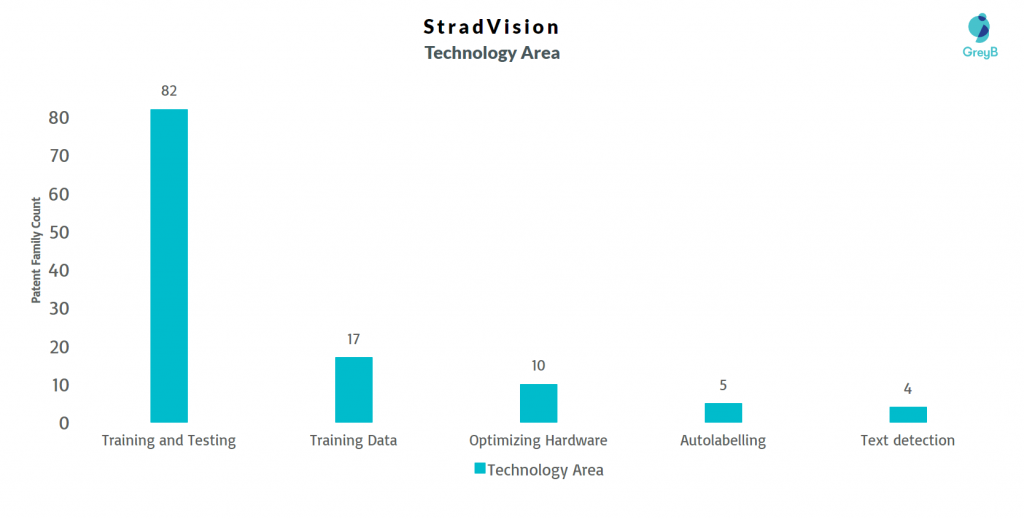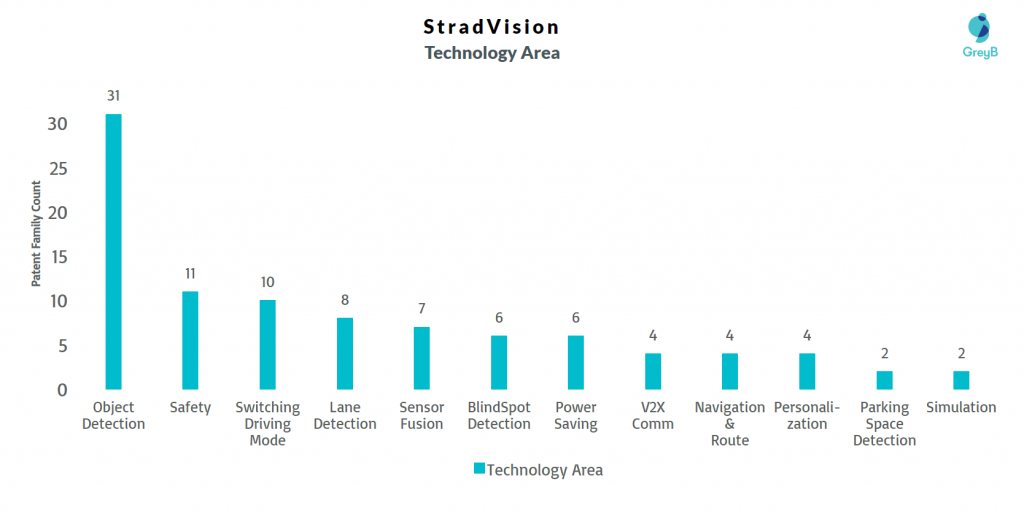StradVision is a Korean self-driving software development company that makes AI-based camera perception solutions for autonomous vehicles and ADAS systems. The company is accelerating the advent of fully autonomous vehicles by making ADAS features available at a fraction of the market cost compared with competitors.
StradVision patents focus on autonomy levels 2 to 4, and on its SvNet software that helps self-driving vehicles to detect and identify other vehicles, lanes, pedestrians, animals, free space, traffic signs, and lights, even in harsh weather conditions or poor lighting.
Below is the division of StradVision’s patents:

StradVision Patents -Deep Learning (118 patent families)
We have divided the cluster into 5 further subgroups for a better understanding of its proprietary software SvNet.

Training and Testing Neural Networks (82 patent families)
One of the most persistent problems with the ADAS solutions in the industry is the challenge of collecting and leveraging high-quality data and training to achieve optimal solutions.
Stradvision’s perception software SvNet is a deep learning-based software that helps train the neural network such as CNN(US10169679B1), RNN(US20200242408A1), GAN(US10373023B1) to find how the machine would react during tasks like object detection, lane detection, navigation. Also ensuring fault tolerance(US10380724B1) in extreme situations like rain and fog.
Stradvision’s perception software is designed in such a way that it learns from its mistakes (US10430691B1) and ensures superior safety and accuracy for lane detection, parking spot detection, blind-spot detection with a reduced computational time (US10043113B1). Owing to this, Ambarella Inc. used SvNet software for its ADAS and DMS demonstration vehicle at the CES 2020.
Another patent US10783438B2 of the cluster discloses an invention whereby there is continuous learning using training data without storing it on a storage device. This in turn ensures saving resources such as storage and also preventing catastrophic forgetting and securing privacy.
Generating Training Data (17 patent families)
For AI to be effective in object detection and recognition, the process of gathering data is as important as the creation of the software. Detecting and tagging data samples involves a detailed training process often requiring expensive and time-consuming manual input from human data labelers.
The Auto labeling tool of Stradvision is designed to be used with SvNet for connecting the dots between recorded data and the AI software (more details in the section below).
The present cluster relates to the maintenance and generation of the databases for training deep neural networks. For each separate frame or image (US10311335B1) or video (US10872297B2) recorded by the vehicle’s ADAS, every object is labeled and in turn compiled into a bank of information as the vehicle’s AI system continues to learn.
Patents in the cluster also disclose the method of evaluating the labeled images for generating data to be used for training the neural networks (US10579907B1), and for generating test patterns to verify whether the parameters of the neural network are the same during the testing and after the learning of the neural network (US10372573B1).
Hardware Optimization (10 patent families)
The patents in this cluster disclose the architectures that could deploy the SvNet software for being able to recognize obstacles in real-time.
Stradvision has very close ties with the SOC developing companies like Texas Instruments, Renesas, to enable the integration of its SvNet to any hardware system.
Stradvision’s SvNet requires less memory and consumes less power for efficient hardware optimization. This allows the system to be able to use the training data for enabling autonomous driving situations in real-time and that too at a lower computational cost.
Stradvision excels in making the most out of the smallest hardware resources. The perception-enabled DNN software developed on high-end processors like Nvidia PX2 is ported on affordable SOCs.
The patent US10325179B1, for example, discloses a computing device that instructs the neural network to generate a feature map based on the image acquired by the camera.
Auto Labelling( 5 patent families)
Stradvision’s SVNet has an auto-labeling system(ALS) that produces training data with minimum human intervention.
For example, patent US10699192B1 talks about a method of optimizing the parameters of the auto-labeling device to solve the problem of conventional labeling which is computationally expensive and fails to deliver good results.
Other patent families in this sub-cluster focus on the inspection (US10373027B1) and evaluation (US10579907B1) of the auto-labeled training images for use in deep learning models to analyze them with high precision.
Text Detection (4 patent families)
The methods for the detection of the text included in the image captured have been disclosed in this cluster. This includes detecting the number plate of the vehicles in the vicinity and also the estimation of characters associated with the signboards.
The patent US9710703B1, for example, deals with a method of detection of texts in an image by allowing another device to classify the text based on the feature value of the pixel in a specific image. The feature value is basically detecting how bright a particular pixel is in an image.
Stradvision Patent Portfolio – Autonomous Vehicles (95 patent families)

This cluster is basically on SVNet’s vision processing algorithms helps in the advanced navigation assist via object detection (US10621473B1), distance estimation (US10551846B1), and parking space detection( US10628688B1) using the information collected from the sensors associated with the car.
The automotive OEMs that Stradvision provides services to are equipped with a camera, LIDAR, RADAR for the generation of the point cloud data to perform effective SLAM. The decision of autonomous driving is based on the output that is generated by the synergy (US10776673B2) of data from all these sensors.
There also are patents that use inter-vehicle communication(V2X) for efficient path planning of the ADAS system. The patent US10780897B2 discloses a method of alerting people about the driving intention of the autonomous vehicle.
All the patents mentioned above use CNN as a tool for the generation of the feature map to let the autonomous vehicle drive without fail. This includes detection of the lanes (US10223614B1), pedestrians (US10303980B1), blind spots (US9947228B1), along ensuring the supreme safety of the vehicle.
Stradvision Patent Portfolio- Camera Technology (6 patent families)
In NVIDIA GTC 2020 and Autosens 2020, Stradvision unveiled their new feature SVM(surround view monitoring) which combines wide-angle images collected by multiple cameras, mounted along the side of the vehicle, to recognize objects and situations in 360 degrees.
Stradvision has also done quite a significant innovation in camera technology. It has use cases related to the front camera (US10373323B1), rearview camera, for surround-view monitoring as well as the intelligent side and rear mirrors for drivers and passenger surveillance.
US10633007B1 discloses driving assistance glasses for a driver. The glass camera develops an image corresponding to the perception of a driver wearing the glass. The glasses may acquire acceleration information and gyroscopic information from sensors and hence be able to detect objects and other obstacles.

